Malone University
 | |
| Motto | Christ's Kingdom First |
|---|---|
| Type | Private |
| Established | Cleveland Bible College: 1892 Malone College: 1957 Malone University: 2008 |
| Affiliation | Evangelical Friends (Religious Society of Friends)[1] |
| Endowment | $16,092,434 (2010)[2] |
| President | David A. King, Ed.D. (January, 2012) |
| Dean | Chris Abrams, Ed.D. |
| Students | 2,559 (Fall 2011) |
| Undergraduates | 2,083 |
| Postgraduates | 476 |
| Location | , United States 40°49′34″N 81°22′36″W / 40.826054°N 81.376545°W |
| Campus | Urban, 96 acres, 23 buildings |
| Colors | Red and White |
| Affiliations | Christian College Consortium, Council for Christian Colleges and Universities, Evangelical Friends Church - Eastern Region, Religious Society of Friends |
| Mascot | Pioneer |
| Website | http://www.malone.edu/ |
Malone University is a private, liberal arts college located in Canton, Ohio, United States. It was founded in 1892 by Walter and Emma Malone as a small, co-educational Bible institute called Cleveland Bible College.[3] In Cleveland, Ohio. The institution has always maintained a close relationship with the Religious Society of Friends (Quakerism).
Malone University holds an affiliation with the Evangelical Friends Church - Eastern Region, a North American yearly meeting of the Evangelical Friends Church International. Despite the university's more Evangelical Christian identity, the community reflects diverse religious backgrounds, with nearly 50 denominations of Christianity and several non-Christian faith practices represented. Though all employees, staff, and faculty of the university are required to sign a statement of faith, Malone students are not required to profess any religious persuasion.
In addition to Malone University's traditional undergraduate college, the school also maintains a competitive graduate school[4] offering masters in a wide field of professional studies, an online school[5] with a variety of bachelors programs, as well as degree completion programs[6] in management and nursing. The Graduate School also has a post-degree professional development center[7] that offers workshops and certificates.
Nationally, Malone University is ranked in the top four percent of colleges and universities in career outcomes, top 10 (#9) best online financial aid packages, and top 50 (#30) most affordable Christian colleges. Regionally, U.S. News & World Report’s America’s Best Colleges 2015 ranks Malone University among the top colleges and universities in the Midwest in the category Regional Universities, and to its list of best online bachelor’s programs. Statewide, Malone appears on the list of colleges offering the best lifetime return on investment in Ohio. Malone University has been recognized by the prestigious Templeton Foundation as a leader in character development, as a military-friendly school by Victory Media, and as one of Northeast Ohio’s top workplaces by the Cleveland Plain Dealer.
Overview and History
Cleveland Bible College
Malone University was founded in 1892, in Cleveland, Ohio, as Cleveland Bible College by Quaker religious leaders J. Walter and Emma Malone.[8] It was established to train young people for inner-city ministry and social service in the Quaker tradition. After beginning with small gains, the school eventually became synonymous with service to the Cleveland community at beginning of the 20th century, growing substantially with every new year. It was originally located at 3201 Euclid Avenue in downtown Cleveland[9] but was eventually forced to relocate in 1956 after the state took the property for constructing Interstate 90.
Malone College
Faced with the decision to stay in Cleveland or move, the board of trustees finally decided on Canton, Ohio as a good location where the school could become a leader in higher education. A thriving industrial metropolitan city at the time, Canton was the only city in the country with a population over 100,000 to not have an institution of higher education. It was this fact, among others, that played a key role in the decision to move the school to Canton on a 150-acre (0.61 km2) property between 30th and 25th streets from north to south, and Cleveland Avenue and Harvard from west to east. At the time of relocation the board also chose to change the name of the school to Malone College, in honor of the school's founders, J. Walter and Emma Brown Malone.
It was also at the time of the move that the school began expanding its academic programs. After only a short time, Malone had gone from a small Bible college in downtown Cleveland to a growing undergraduate college in the liberal arts tradition in Canton, Ohio offering degrees in education, political science, history, music and psychology. This was all a part of the overall mission of the board to use the forced move as an opportunity to grow the institution and become a regional leader in broader fields of professional and academic studies.
Malone University

In February 2008, the Malone College board of trustees voted unanimously to rebrand as Malone University. The move to a university reflected a transition that had capped off in 1999, when Malone adopted a university structure on which to operate. According to the institutional press release, the transition to Malone University reflected the institution's "mission and emphasized the potential for enhanced educational opportunities within the liberal arts context for the growing number of undergraduate students already studying in 90 different academic programs".[10] The rebranding process took place under the leadership of then-president Gary Streit.
Since becoming a university in 2008, Malone has experienced growth in not only in academic offerings, but also in student enrollment and campus property. In 2009, the university completed construction on its newest residential hall, Blossom Hall. The residence facility was named in honor of long-time philanthropist and former president of the Cleveland Orchestra, Dudley S. Blossom.[11] The university currently sits on 96 acres (390,000 m2) and enrolls 2,083 undergraduate and 476 graduate students from 33 states and 17 countries.
Academics

There are four colleges and schools within the university.[12] Though these schools have undergone much expansion since Malone rebranded as a university in 2008, each school has operated independently since the late 1990s.
- College of Theology, Arts, and Sciences
- School of Nursing and Health Sciences
- School of Business and Leadership
- School of Education and Human Development
Malone's more well-known academic degree programs include Computer Science, Nursing, Communications, Pre-Medical Sciences (Pre-Vet, Pre-Med, Pre-Optometry, Pre-Dental), Zoo and Wildlife Biology, Music performance, Music production, Music ministry, Music education, Education, and Business Administration. Malone University offers Bachelor of Arts and Bachelor of Science degree programs in more than 80 areas of concentration. In addition to the university's 80 academic majors, the institution offers 40 academic minors. The average class size is 22 with a student-faculty ratio of 14:1 (2011-2012).
Student Life
Though there are approximately 2400 undergraduate and graduate students enrolled at the university, the majority of the student population are commuters from surrounding areas within a 60 miles radius or online. Malone's residential population consistently hovers around 1,200. Because of this, the campus life prides itself on a high level of community and connectedness. All students are encouraged to take part in community-building activities both in and outside of the classroom. Incoming students are required to sign a "Community Agreement," which stipulates the expectations of members of the Malone community.
The university offers campus-wide events and activities through the Student Activities Council (SAC), and has more than 75 clubs and organizations for students.
Special Interest
From service organizations to special interest clubs, some of these groups include:
- 25th St. Productions - student-run record label
- AVISO (Campus newspaper)
- be:Justice - social justice awareness
- Celebration - student led worship service
- Commuter Connections Council
- Diversity Ambassadors
- Forensics - CSI
- Quaker/Friends Group
- Multicultural Student Union
- Open Frame Film Festival - annual student film festival
- Students in Free Enterprise (SIFE)
- College Democrats
- Young Republicans
- Student Senate (SGA)
Academic
Malone also offers academic organizations and honor societies:
- Alpha Gamma Chapter of Sigma Zeta
- Alpha Psi Omega
- Communication Arts Club
- Eta Sigma Gamma
- Future Scientists of Malone
- Honors Society of Nursing/Sigma Theta Tau International
- Kappa Delta Pi Education Honorary
- Pi Sigma Alpha
- Psychology Club
- Sigma Delta Mu
- Social Work Club
- Sigma Theta Tau International
- Zoological Organization of Malone (ZOOM)
Athletics
The Malone Pioneers are the athletic teams of Malone University. The university is a member of the NCAA and competes at the Division II level in the Great Midwest Athletic Conference (GMAC) after a few seasons in the Great Lakes Intercollegiate Athletic Conference (GLIAC). The university offers 18 sports, including: baseball, men's and women's basketball, men's and women's cross country, football, men's and women's golf, men's and women's soccer, softball men's and women's swimming and diving, men's and women's tennis, men's and women's track & field, and women's volleyball.[13]
Prior to Malone's NCAA Division II membership, the Pioneers participated in the National Association of Intercollegiate Athletics (NAIA) and the American Mideast Conference (AMC).[14] For football, the school competed in the Mid-States Football Association (MSFA) until the university's second year of NCAA candidacy in the 2011-2012 academic school year. The multiple-year transition process in which Malone was not eligible to compete in NCAA post-season competition began in July 2010 when Malone was granted an exploratory membership to the NCAA Division II. In October 2011, Malone was accepted as a member of the GLIAC[15] for all 18 intercollegiate athletic programs. The university met all requirements and graduated to provisional status before Malone became a full member of the NCAA in July 2013.[16]
Notable alumni
- Laban Coblentz, writer, educator, science policy advisor, international civil servant, entrepreneur.
- Susan Norris Fitkin, founder and 1st president of Nazarene Missions International
- Robin Meade, CNN anchor (graduated from Ashland University, but attended Malone before transferring.)
- Tony Migliozzi, ultra-marathoner and 2015 IAU 50 km World Champion
- Jeff Timmons, founding member of vocal group 98 Degrees[17]
- Timothy Mack, 2004 Olympic Gold Medalist in the Pole Vault, multiple-time USATF Champion (also attended University of Tennessee)
- John B. Ellington, Jr., Air National Guard general
- Christina Hagan, member of the Ohio House of Representatives beginning with her appointment in 2011.
References
- ^ A Guide to Christian Colleges. Christian College Coalition. 1982. Retrieved 12 December 2011.
Founded upon a deep commitment to evangelical Christian faith, Malone has an interdenominational outreach while being affiliated with the Evangelical Friends Church— Eastern Region.
- ^ Malone University | Best College | US News
- ^ "Cleveland Bible College". Ohio History Central. Retrieved 2010-10-02.
- ^ "Malone University Graduate Studies". Malone University. Retrieved 2010-10-09.
- ^ "Malone University Online School". Malone University. Retrieved 2010-10-09.
- ^ "Malone University Degree Completion". Malone University. Retrieved 2010-10-09.
- ^ "Malone University Professional Development". Malone University. Retrieved 2010-10-09.
- ^ "Cleveland Bible College".
- ^ "Cleveland Memories""Cleveland Bible College Administrative Building".
- ^ http://www.amcsports.org/news/2008/10/3/mal_university100308.aspx
- ^ MU to Dedicate Blossom Hall: Stark County, Ohio Community Events
- ^ "Schools and Departments of the University".
- ^ Malone College : Athletics
- ^ American Mideast Conference
- ^ Malone University - Malone, Walsh Accepted Into GLIAC
- ^ Looney, Josh (July 15, 2013). "Division II adds new conference, members". NCAA. Retrieved July 27, 2013.
- ^ Brereton, Erin; Fantle, David; Helmes, Amy; Johnson, Thomas; Sahn, Geri (2000). John Delavan (ed.). 98° – Revelation. H&S Media. p. 46. ISBN 978-1-57243-404-2.
External links
- Malone University
- Quaker universities and colleges
- Universities and colleges in Ohio
- Educational institutions established in 1892
- Education in Stark County, Ohio
- Buildings and structures in Canton, Ohio
- 1892 establishments in Ohio
- Visitor attractions in Canton, Ohio
- Evangelicalism in Ohio
- Council for Christian Colleges and Universities
